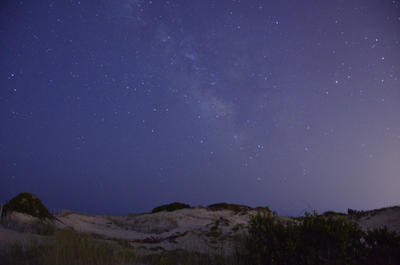Coypright Sequoia - used with permission
Ever wonder how those stunning images of the stars and milky way you see are taken?
Ever want to do those yourself?
You've come to the right place.
Recently I got into astrophotography and figured I'd share the love, since nearly every person I showed it to asked "How did you do that?".
Step by step starts NOW.
1) Get your shit together. Tripod is ESSENTIAL if you have one. Remote shutter release is helpful. Oh, and you'll need a night sky. One with little to no light pollution, no clouds, and little air traffic (best around 2-4 am).
2) Pick your spot and angle to sky, remember that the foreground content will be illuminated and plays a big role in the overall appeal of the picture. Take a few practice shots using the flash to see what it will look like without the stars. A great star picture involves both breathtaking stars and an interesting foreground.
-Also, Look for what looks like a long cloud stretching across the sky at a diagonal angle. Almost foggy, but not blocking stars. If you can see this, you're in luck. That's the milky way. INCORPORATE IT. You won't be disappointed.
3) Set up your tripod. Now you can set your DSLR on a bench or something as long as it will not move a fraction of an inch in 30 seconds...not recommended though.
4) Open your aperture as WIDE as it goes (that's a low f stop number if you didn't know). My lens only goes down to f/3.8, a lot go lower. This is good, you want to let as much light in as possible. If you have an f/1.4 lens or faster, it is recommended to stop down to f/2 for better detail though. F/2 is optimal.
5) When shooting stars, your shutter speed is very important. Too long and your stars will come out not as dots, but as lines. Too short and the stars won't show up. A good rule to go by is the 600 rule. Divide 600 by your focal length, that is the shutter speed (in seconds) you can shoot up to till the stars start streaking. Example: 600/24 (focal length) = 25 seconds. So with a 24mm lens, you can shoot up to 25 seconds without having the stars turn out as lines. This is only a guideline. When shooting stars, it is recommended that you take shots at different shutter speeds to see what works best.
6) When setting your ISO, you generally want to use a high ISO. Of course, this is going to give a grainy picture, but there's little you can do about it. If you have a modern camera or full frame camera, you should be able to shoot at 3200 ISO and still get good results. If you're in a really dark environment with a fast and wide lens, you can probably shoot at 1600 ISO (or even lower)
7) Lastly, make sure you are shooting in RAW so you can adjust the whitebalance in post. Your camera will do a terrible job with getting the WB right, shooting in RAW will give you the flexibilty to get it right on your computer. You're probably going to end up with a temperature between 2800 and 3100 Kelvin.
8) Finally, set use your shutter release or self-timer and FIRE! Make sure not to touch your camera, or you'll end up with a blurry picture.
If all goes well, you should be pleased and blown away by what your camera can do. It's picking up light sources from billions of lightyears away. How's that for telephoto?
--Try to time it so there will be no planes streaking across your shot. Nothing ruins a great picture better than a white and red dash across the frame
--Take a bunch of pictures! You have all night, and the chances of getting another clear night the next night are low.
If your camera has long exposure noise reduction, take one picture with it on and one picture with it off. Sometimes it will eliminate the tiny stars and take away from your shot, yet other times it will do you great justice in removing annoying foreground noise.
Examples! I shot all of these at 30" f/3.8 ISO 2500 with noise reduction OFF (forgot about it)



3 errors in this one: Bland foreground (note difference in next exposure), crooked horizon, and the plane seen in the middle

My personal favorite/best

Best part about these, people go NUTS for them. Bitches, on your dick. Because your camera can see the milky way.
"My camera can see the milky way. What can you do?"

